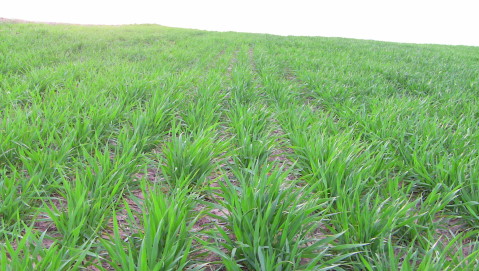
Agricultural News
Producers May Not Need to Use Nitrogen on Wheat in 2011
Thu, 03 Nov 2011 08:44:16 CDT
 It's said that every cloud has a silver lining. As we approach the end of 2011, the rather tarnished silver lining in the very uncloudy year is that many soil sample results have considerably higher than average amounts of nitrates, especially in wheat and winter pasture fields. What does this mean? It means that you may be able to reduce or eliminate nitrogen (N) fertilizer this year.
It's said that every cloud has a silver lining. As we approach the end of 2011, the rather tarnished silver lining in the very uncloudy year is that many soil sample results have considerably higher than average amounts of nitrates, especially in wheat and winter pasture fields. What does this mean? It means that you may be able to reduce or eliminate nitrogen (N) fertilizer this year.
Don't read the title of this article and immediately call the dealership and cancel your fertilizer purchase. All soil samples are not high in residual nitrates. The only way you can know if your fields have high amounts of residual nitrogen is to take good soil samples and rely on the results. The standard 0- to 6-inch soil sample is OK for this purpose, but taking an additional 6- to 12-inch sample will show how much N is in the subsoil and may allow you to cut N rates even further.
We usually see less than 20 pounds of N per acre in the nitrate form in a soil sample analysis. This year, it is not unusual to see more than 100 pounds of N per acre in the nitrate form. What is the reason for the increase in residual N in soil sample analyses?
One obvious reason is that very little nitrogen fertilizer that was applied last winter or spring was used by plants this year. Between the extremely cold and dry weather in the winter and the extremely hot and dry weather in the spring and summer, plant growth was abysmal. If you applied nitrogen fertilizer to fields in fall 2010 or during the spring or summer of 2011, a lot of it may still be in the soil since there was not much plant uptake to remove it. Little, if any, nitrogen was lost from the soil by leaching or denitrification since the mechanism for these types of N loss involves heavy rainfall. Nitrogen loss through heavy rainfall has not been a problem at all this year.
Another reason for more nitrogen carryover this year involves a natural phenomenon. About 20 to 30 pounds of nitrogen per acre are mineralized from each 1 percent of organic matter over a growing season. In most years, this nitrogen is quickly utilized by plants. However, since there was very little plant growth this year, most of this nitrogen is probably still in the soil.
The best way to determine if your residual nitrogen levels are high enough to allow you to reduce your nitrogen fertilizer rate is to take good soil samples. The results will give you the best information on the amount of residual nitrogen that you have, and you can use that information to make nitrogen rate decisions.
Another way to determine if you can reduce nitrogen rates is to apply a N-rich strip in your field. Apply a high and a medium rate of N in your field in strips, or in small areas you can identify, and compare the unfertilized areas with the fertilized areas at topdressing time. If the color, thickness or height of the plants in the unfertilized areas is as good as both fertilized strips, you can probably eliminate fertilizer without sacrificing yield. If the unfertilized areas look as good as the medium fertilizer strip, but not as good as the high fertilizer strip, you can decide if the yield from the equivalent of a medium amount of N is good enough for you or if you want to apply some N to have your plants look like ones in the high N areas.
A low tech method of a N-rich strip can be done by comparing unfertilized plants to plants in manure pile areas. If you can detect significant differences in height, thickness and color between the unfertilized areas and the manure pile areas, you probably need to add fertilizer.
I want to stress that not everyone can reduce or eliminate fertilizer in winter pasture fields this year without sacrificing yield. You should only do this if you take soil samples or apply a N-rich strip. However, I have seen several situations this year where soil sample results allowed me to save a farmer up to $60 per acre by not recommending unnecessary fertilizer.
Our thanks to Eddie Funderburg, Senior Ag Consultant for the Noble Foundation, for providing this article on nitrogen levels in wheat for 2011.
Click here for more Ag News and Views from the Noble Foundation.
WebReadyTM Powered by WireReady® NSI
Top Agricultural News
More Headlines...


















